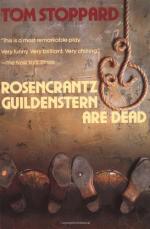|
This section contains 7,528 words (approx. 26 pages at 300 words per page) |

|
SOURCE: '"Wheels within Wheels, etcetera': Artistic Design in Rosencrantz and Guildenstern Are Dead," in Comparative Drama, Vol. 15, No. 4, Winter, 1981-82, pp. 291-310.
In the following essay, Gruber maintains that Rosen-crantz and Guildenstern Are Dead is not merely a pastiche of elements of Hamlet; rather it is a technically innovative play that mirrors classical tragedy.
Tom Stoppard's Rosencrantz and Guildenstern Are Dead ought to cause us to acknowledge some inadequacies in the vocabulary we currently use to discuss plays, and the nature of our shortcoming can be demonstrated, I think, with some representative summaries of Stoppard's art. Ruby Cohn, for example, suggests that Stoppard proved "extremely skillful in dovetailing the Hamlet scenes into the Godot situation" [Modern Shakespeare Offshoots, 1976]; Ronald Hayman writes that "Stoppard appeared at the right moment with his beautifully engineered device for propelling two attendant lords into the foreground" [Tom Stoppard, 1977]; Charles Marowitz comments that...
|
This section contains 7,528 words (approx. 26 pages at 300 words per page) |

|


